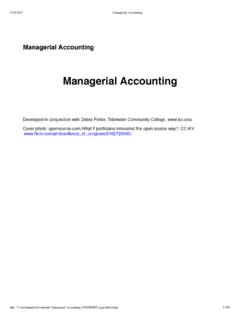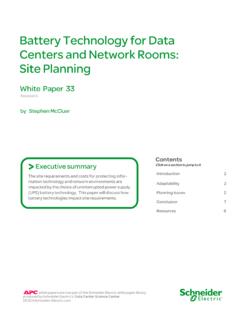Transcription of QUALITY CONTROL: How Samsung Is Using Data to Mitigate the ...
1 1 MIT technology Review CustomIN PARTNERSHIP WITHS amsung has rebounded from its battery -related challenges by expanding its fault resolution capabilities. It is now positioned to revolutionize the manner in which the global smartphone industry mitigates future Samsung Is Using data to Mitigate the battery Challenge QUALITY CONTROL: IN EARLY AUGUST 2016, Samsung Electronics enjoyed a prominent position in the global smartphone industry and was poised to launch an innovative, new flagship product. The Galaxy Note7 with its unique sleek form factor and such industry-leading features as its curved Quad HD Super AMOLED display had been highly anticipated by industry watchers, bloggers, and consumers worldwide for months.
2 By the end of that month though, reports of Note7 incidents began to surface, ultimately precipitating a global recall. Samsung quickly identified the problem: a battery short circuit caused by a deflection of the negative electrode. CT and X-ray scans revealed the jelly roll (a design used in most rechargeable lithium-ion batteries) was compressed in the battery pouch, which weakened the separator between the two electrodes. This created multiple paths to short engaged a second supplier one that was already providing a portion of the original Note7 batteries on a global scale without incident. That second Note7 battery supplier confirmed that it could meet the worldwide demand for the Note7 replacement devices.
3 However, a separate, distinct battery failure soon emerged in these replacement batteries. This one was caused by abnormally high burrs on the positive electrode tab due to ultrasonic-welding Control: How Samsung Is Using data to Mitigate the battery Challenge2 MIT technology Review CustomUltimately, Samsung withdrew the Note7 from the market less than two months after its launch, with industry reports estimating the company has lost some $10 billion in sales. Almost as quickly as the recall process played out, Samsung implemented a safety-management program unparalleled in its scope and size for the mobile industry. Augmenting existing battery tests and creating new levels of testing, Samsung developed a holistic QUALITY and safety frame-work known as the 8-Point battery Safety Check, which both built upon and improved existing benchmarks.
4 Samsung instituted these inspection and review processes across both Samsung s and its battery suppliers QUALITY assurance processes from producing the individual components that make up the device itself through the process of putting those components together and assembling the phone to the very end, when the completed device was subject to additional tests. The lithium-ion business is highly varied and stratified, with many different types of suppliers, making batteries for everything from e-cigarettes and hover boards to smartphones, says Jack Gold, principal analyst at industry researcher J. Gold Associates, LLC. Gold says that Samsung got a bloody nose from the Note7 battery incidents, which in his opinion prompted a response completely unique for manufacturers of finished devices.
5 They looked at failures, and tried to determine exactly where in the process those failures occurred, he says. Determining the root cause was only half the battle. From there, Samsung worked on creating a new, comprehensive testing protocol based on the findings of their investigation. Gold says this was perhaps made more pressing for Samsung because it is one of the few smartphone manufacturers that actually have more control of its production processes. Figuring out which tests should be conducted is the important piece, he says. If you are building a device, this is what you should check. The lithium-Ion business is highly varied and stratified, with many different types of suppliers, making batteries for everything from e-cigarettes and hover boards to smartphones.
6 - Jack Gold, Principal Analyst at industry researcher J. Gold Associates, Control: How Samsung Is Using data to Mitigate the battery Challenge3 MIT technology Review CustomThe electronics giant developed this testing regime in consultation with an independent battery Advisory Group. This group includes four experts three from academia and one from the industry who now regularly review Samsung s processes and responses to issues related to battery materials, design, and dynamics. We have made significant investments in order to cast the widest possible net [to find solutions], says Justin Denison, senior vice president, Product Strategy and Marketing at Samsung Electronics America.
7 The company has custom-built mass-scale testing facilities, which helps its engineers detect production issues and validate the QUALITY and safety of devices before they are released. Samsung is not only achieving its primary goal of boosting product QUALITY , but is seeking to elevate the manner in which the entire industry manages fault monitoring and QUALITY s enhanced safety program includes expanded testing processes throughout the production chain to ensure that devices and all device components are safe. It is now Using larger sample sizes, often involving lots in excess of 100,000 units, and increasing integration with its suppliers testing processes.
8 We have increased the sampling size of many of the tests by a significant factor, says Dr. Tae Moon Roh, executive vice president, head of Hardware R&D of Samsung Electronics Mobile Communications Business, during a recent tour of Samsung s smartphone factory in Gumi, South of lithium-ion batteries flow through Samsung s global supply chain every month. We realized we had to enhance our processes, and find new methods, if we were to create a system that could embrace both static detection and be dynamically responsive at such scale, says Dr. also undertook a far-reaching initiative aimed at increasing its ability to Mitigate the risk of failure.
9 This complex project has increased the company s ability to systematically and comprehensively detect battery failures. More importantly, it has also created an immense volume of data on the phenomenon of smartphone battery failure itself. In other words, their operational scale has provided Samsung with an invaluable knowledge base that may help accurately predict and proactively Mitigate production issues yet to come and share those findings across the industry. An Industry under Pressure Samsung s battery challenges were set against a backdrop of growing speed and complexity in the smartphone industry. The intensity of this production environment placed extraordinary pressure on all participants throughout the supply chain.
10 The smartphone product cycle as with all consumer electronics in general has to move at an increasingly fast pace because of several factors: the endless race all manufacturers run to maintain competitiveness; QUALITY Control: How Samsung Is Using data to Mitigate the battery Challenge4 MIT technology Review Custom advances in the capabilities of software, application, and mobile-network infrastructure; and the constantly increasing demands of consumers for new and improved smartphone features and performance. The pressure this places on battery and component producers has meant tolerance for failure has decreased [massively across the industry], says Gerbrand Ceder, professor of materials science and engineering at the University of California at Berkeley, and a member of the battery Advisory Group.



















